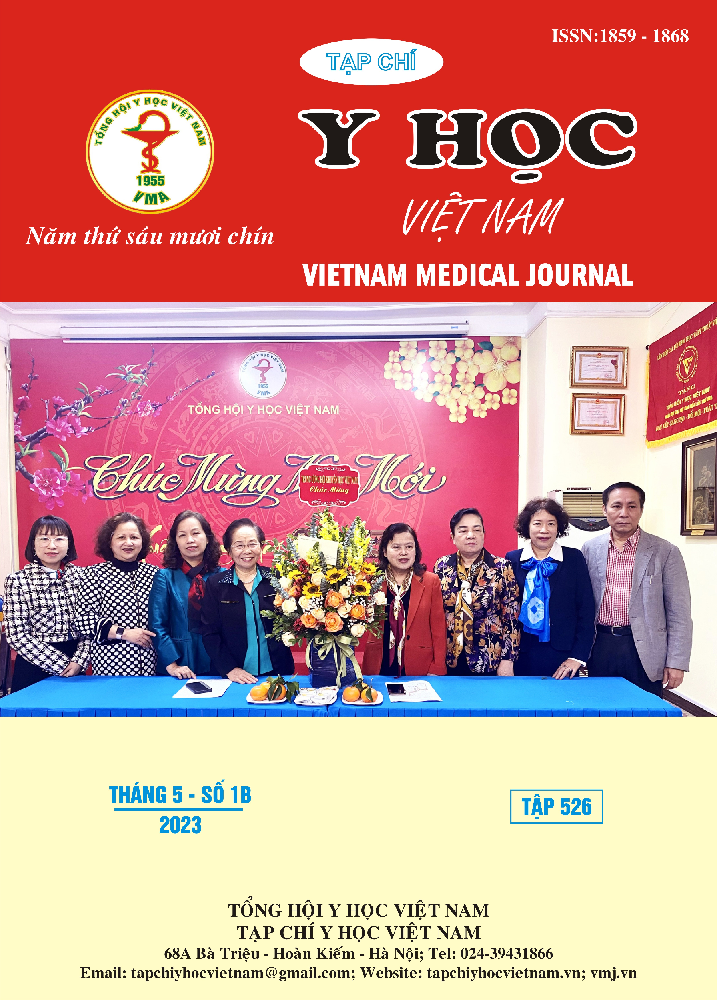RELATIONSHIP BETWEEN PLGF, sFLt-1 LEVELS WITH SOME CLINICAL FEATURES AND BIOCHEMICAL INDICATORS IN PRENANT WOMEN AT RISK OF PRE- ECLAMPSIA
Main Article Content
Abstract
Objectives to study the relationship between PlGF, sFlt-1 levels and sFlt-1/PlGF ratio with some clinical characteristics and biochemical indicators in pregnant women at risk of pre-eclampsia in the first trimester of pregnancy in Thai Nguyen. The study was conducted on 201 pregnant women with risk factors for preeclampsia and 200 normal pregnant women at gestational age in the first trimester of pregnancy with a gestational age of 11 weeks to 13 weeks and 6 days. Cross-sectional descriptive research method, the study results showed that the concentration of PlGF, sFlt-1, the ratio sFlt-1/PlGF were more related to age and related to systolic blood pressure, diastolic blood pressure. Levels of PlGF, sFlt-1 in pregnant women at risk of preeclampsia have little association with biochemical indices as well as some other clinical features in the first trimester of pregnancy. The concentration of PlGF, sFlt-1 and especially the ratio sFlt-1/PlGF can help in early diagnosis of pre-eclampsia before the appearance of clinical symptoms, according to the ROC curve, the area under the curve (AUC) of PlGF in pre-eclampsia screening was 0.717 with p < 0.001; of sFlt-1/PlGF in pre-eclampsia screening was 0.778 with p < 0.001, especially PLGFwith sensitivity and specificity of the ratio sFlt-1/PlGF were 79.1% and 67.5%, respectively. When considering each index, PLGF has a sensitivity of 60.1% and a specificity of up to 71.1%.
Article Details
Keywords
Pre-eclampsia, screening, first trimester of pregnancy, PLGF, sFlt-1
References
2. Nguyễn Chính Nghĩa, Phạm Thiện Ngọc, Nguyễn Quốc Tuấn (2011). “Nghiên cứu nồng độ yếu tố tân tạo mạch máu PLGF và yếu tố kháng tân tạo mạch máu SFLt-1 trong huyết thanh thai phụ có nguy cơ tiền sản giật, Tạp chí Y học Việt Nam, tập 384, tháng 8/2021 tr: 99-104.
3. Akolekar R, Syngelaki A, Sarquis R, Zvanca M, Nicolaides KH (2011). Prediction of early, intermediate and late pre-eclampsia from maternal factors, biophysical and biochemical markers at 11-13 weeks. Prenat Diagn. 2011 Jan; 31(1), 66-74
4. Lim JH, Kim SY, Park SY, Yang JH, Kim MY, Ryu HM (2008). Effective prediction of preeclampsia by a combined ratio of angiogenesis-related factors. Obstet Gynecol 2008;111(6):1403–9.
5. Levine RJ, Maynard SE, Qian C, Lim KH, England LJ, Yu KF, Schisterman EF, Thadhani R, Sachs BP, Epstein FH, Sibai BM, Sukhatme VP, Karumanchi SA (2004). Circulating angiogenic factors and the risk of preeclampsia. N Engl J Med 2004;350(7):672–83.
6. De Vivo A, Baviera G, Giordano D (2008) Endoglin, PlGF and sFlt-1 as markers for predicting pre-eclampsia. Acta Obstet Gynecol;87:837-842
7. Sunderji S, Gaziano E, Wothe D, Rogers LC, Sibai B, Karumanchi SA, Hodges-Savola C (2010). Automated assays for sVEGF R1 and PlGF as an aid in the diagnosis of preterm preeclampsia: a prospective clinical study. Am J Obstet Gynecol 2010;202(1):40–7.
8. Stefan V, Alberto G, Dietmar S, Harald Z, Ignacio H, Manfred G, Juliane P, Joachim W, Barbara D, Holger S (2010), An automated method for the determination of the sFlt-1/PlGF ratio in the assessment of preeclampsia, 2/2010 American Journal of Obstetrics & Gynecology 161.e11


